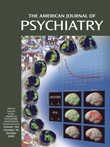Relationship Between a High-Risk Haplotype in the DTNBP1 (Dysbindin) Gene and Clinical Features of Schizophrenia
Abstract
OBJECTIVE: The purpose of this study was to determine whether a haplotype in the dystrobrevin binding protein 1 (DTNBP1) gene previously associated with schizophrenia not only increases the susceptibility to psychotic illness but also to a more or less clinically specific form of psychotic illness. METHOD: In the Irish Study of High-Density Schizophrenia Families, subjects with psychotic illness (N=755) were given lifetime ratings of clinical features according to the Operational Criteria Checklist for Psychotic Illness. Exploratory and confirmatory factor analyses were used to extract five factors—hallucinations, delusions, negative, manic, and depressive symptoms—and to create factor-derived scores. The family-based transmission disequilibrium test operationalized in the program TRANSMIT was used to determine whether a high-risk haplotype in the DTNBP1 gene was overtransmitted to subjects in the upper 20th and 40th percentiles for each factor score. These results were compared to baseline overtransmission by examining the empirical distribution of chi-square statistics in groups of 5,000 replicates in which 20% and 40% of ill subjects were randomly selected. This analysis was done for both narrow and broad definitions of psychotic illness. RESULTS: Subjects in the upper 40th percentile for the negative symptom factor—in both the narrowly (p=0.004) and broadly (p=0.01) defined illness groups—were more likely to inherit the high-risk haplotype than would be expected by chance. No other significant relationships between clinical features and high-risk haplotype transmission were observed. CONCLUSIONS: The etiologically relevant variation in DTNBP1, which is in presumptive linkage disequilibrium with the high-risk haplotype, may predispose individuals to a form of psychotic illness associated with high levels of negative symptoms. This finding supports previous evidence suggesting that genetic factors influence the clinical heterogeneity of schizophrenia.



